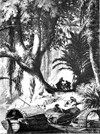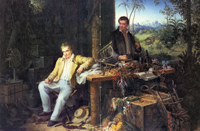| Meeting 6 • 26 January 2012 • Thursday |
Version: |
|
picture of the week |
thought-bite of the week: |
|
|
"[I]n these countries nobody would dream of going out to look for alpine plants, or to study rock strata, or take barometers up to high altitudes. They are used to a dull domestic life; [apparently] they live not to enjoy life but to prolong it." |
|
mini-text of the week (start): "The farm we lodged at was a fine sugar-cane plantation.… The owner's house is situated on a hillock surrounded by huts for the negroes.…" Humboldt, "Personal Narrative", from Jaguars and Electric Eels, ed. & trans. Wilson, p. 22 (read more) |
|
|
<< top (held over from Week 2): Humboldt's canoe (source: Botting, Humboldt and the Cosmos, p. 103 [0027]) |
|
(X') = anticipated time in minutes (total=75) |
(0001) etc.=item in Humboldt Project document collection |
|
Key to notes added AFTER the class meets: |
|
|
√ = topic / activity that was adequately dealt with during the class |
+ = topic that was started but needs more attention & will be resumed at next / subsequent meeting(s) |
|
- = a topic / activity that was proposed though not begun, but will be taken up later |
|
|
Italic bold green text like this = comments after the meeting |
|
|
(10')√ Mini-text of the week: The tricky topic of slavery. How long and where has it existed (not; "did it use to exist")? What is the origin of the word in English and related languages, what words are used for it in other languages, and what does this tell us about slavery over history? See the mini-text of the week for Humboldt's quantitative discussion of slavery, and how that discussion can get teachers into trouble. |
|
|
|
(10')√ Review of the quantitative activities at the past two meetings. Inventory of quantitative problem-solving skills, ready knowledge, and anxiety / confidence. A moment of thanks for Archimedes & Euclid, the triangle & pi, and the ancient Egyptians who built the Pyramids and did so much to invent surveying and irrigation. |
|
+ |
(30') SINQing the Humboldt canoe, so that we can then load it and travel safely in it. 1) "Brute force" solution: actually sinking a similar canoe - will try to arrange it; 2) "Semi-Brute Force Solution: "dry dock" simulation using Laura Dassow Well's description of Humboldt's canoe and its cargo of people, equipment, and various critters- we'll do that right in the classroom; 3) "Smart Person Solution": saving time and sweat by (e-)pencil-and-paper calculation of volume and "ball park" estimation of weight and displacement. Maybe: Worksheet about volume, weight, and displacement |
| + |
(10') presentation (continuation) about educational standards and their parts in the course: 1) evaluating own education; 2) helping others to learn - how standards are used to develop curriculum (curricula?) and learning activities; 3) introduction of writing assignment #3. |
|
- |
(10') about writing skills - the "Leaving Home" assignment |
|
+ |
(5') Checkups & Previews: Does everyone have the main texts and know where to find assignments and deadlines? Has everyone read the Wikipedia article about AvH? Has everyone done the several questionnaires? (Intake experiences • Skills inventory I • |

